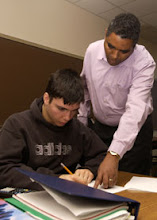Businesses have a nifty, IRS-friendly way to insure their ability
to replace worn/torn, deteriorated or obsolete property and, thus, sustain their
long term livelihood. According to the IRS businesses are permitted to take an
income tax deduction to recover the depreciation cost of tangible property such
as buildings, machinery, vehicles, furniture and equipment and some intangibles
such as patents, copyrights and computer software. Just for clarity, depreciation
is to tangible assets, what amortization is to intangible assets. These write-offs are no small chunk of
change! In 2009 depreciation accounted
to $1, 866.2 billion dollars, $1,874.9 in 2010, $1,950.1 in 2011 and 2012
shaping up to be even better—$ $2,004
billion dollars!
Now, to be considered depreciable an asset must possess at
least two characteristics: a limited useful life and depreciation estimable
with reasonable accuracy. I would argue
that the human capital investment, i.e. a college degree, as an intangible asset
on par with intellectual property or computer software and easily meets both criteria. Education has a limited shelf life. Knowledge churns daily. I would further argue that it—like the aforementioned
intangible assets—suffers from “consumption, expiry, obsolescence or other
decline in value as a result of use or passage of time.”
So what my point? Simply
put, that human capital investment is as important, if not more
important, to our economy’s long run growth than physical capital investment. That without the ability to write down the “consumption,
expiry, obsolescence or other decline in value as a result of use or passage of
time,” we stand to stymie the conduit for stimulating economic growth in the 21st
century. And this is all the more true in the current macroeconomic environment.
According to the Survey of Consumer Finances released by the
Federal Reserve last week:
“Families’ income also continued to decline, a trend that predated the crisis but accelerated over the same period. Median family income fell to $45,800 in 2010 from $49,600 in 2007.”
“Families’ income also continued to decline, a trend that predated the crisis but accelerated over the same period. Median family income fell to $45,800 in 2010 from $49,600 in 2007.”
“The survey also found a shift in the reasons that families
set aside money, underscoring the lack of confidence that is weighing on the
economy. …Fewer said they were saving for retirement, or for education,
or for a down payment on a home.”
“…the share of families with education-related debt rose to
19.2 percent in 2010 from 15.2 percent in 2007. The Fed noted that education
loans made up a larger share of the average family’s obligations than loans to
buy automobiles for the first time in the history of the survey.”
In fact, student loan debt now at more than a
trillion dollars exceeds the nation’s credit card debt!
All this on top of labor market unable to absorb new workers—estimates
of joblessness and underemployment range above fifty percent for college
graduates.
The Great Recession effectively drove home the implication
of “skills obsolescence” for hundreds of thousands of laid off workers. We need stretch the imagination very little
to see the pending implications of “education obsolescence” for hundreds of
thousands of new graduates!
Allowing the cost of education to be amortized like patents
and computer software would seem to be a legitimate, equitable method for addressing the current
student debt crisis, as well as, for insuring the human capital investment pipeline
for long run economic growth remains open despite short run fluctuations in the
economy.
Am I wrong?
 Kay Strong, Ph.D., Southern Illinois University, M.T., University of Houston, M.A., Ohio University; Associate Professor at Baldwin-Wallace College; Areas of expertise: international economics, contemporary social-economic issues, complexity and futures-based perspectives in economics. E-mail: kstrong@bw.edu
Kay Strong, Ph.D., Southern Illinois University, M.T., University of Houston, M.A., Ohio University; Associate Professor at Baldwin-Wallace College; Areas of expertise: international economics, contemporary social-economic issues, complexity and futures-based perspectives in economics. E-mail: kstrong@bw.edu

Never discovered such informatory contents
ReplyDeletehttp://mypaydayloan-quick.info/?page_id=10">quick payday loans
The stuff you are writing blows out my mind.
ReplyDeleteclick for cheap loans direct
Will it affect our economy in the future if ever the problem on student loan continue to increase? If so, did our financial authorities find ways in order to fix the overflowing number of student loan defaults?
ReplyDeleteI like all details that you provide in your articles.
ReplyDelete"cash advance loans online"
Wasp dudes! Awesome stuff keep it up.
ReplyDeletepayday advance loan
I don’t think many of websites provide this type of information.solar pannel for home california
ReplyDeleteWasp dudes! Awesome stuff keep it up.
ReplyDeleteupsidedowncarloan.net
I'm in no doubt coming back again to read these articles and blogs.
ReplyDeletepikavipit
You might comment on the order system of the blog. You should chat it's splendid. Your blog audit would swell up your visitors. I was very pleased to find this site.I wanted to thank you for this great read!! national payday loan relief
ReplyDelete